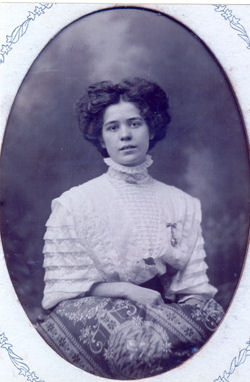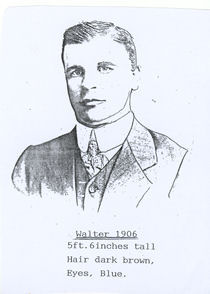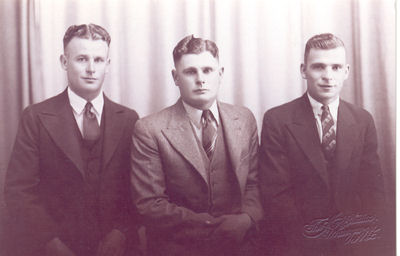

SOLOMON SAUL - MORE INFORMATION ON DESCENDANTS
from John Slaughter
This article was originally published in the December 2009 edition of Soul Search, the journal of The Sole Society
Mention in past journals of Solomon Saul, the man who changed his name from Saul Solomon, continues to attract new enquires and bring forth new information. The latest enquiry came from Merilyn Priestley in New Zealand, who I am grateful to for providing new information and photographs, including details of the War records of some of the descendants and which is the main subject of this article.
One of Solomon Saulís children was a Charles Saul who in the mid 1880ís moved from Liverpool to Aldershot, Hampshire from where he carried on a business as a fishmonger. He died at the relatively young age of 56 in 1902.
One of Charlesís sons, Walter, born in 1881, went to South Africa with the Queens Constabulary during the Boer War and stayed there afterwards in the South Africa Mounted Police. He returned to the UK in 1906 where he met Eleanor Louisa Holton. They married in Durban, South Africa in 1909. They had three boys during their time in South Africa, Walter Richard Charles, born 1910 and twins Cecil Francis and Norman Priestley born in 1912. In 1916 Walter wished to enlist but was refused permission. So he resigned and returned to the UK. However he was subsequently wounded and invalided out. In 1919 he emigrated to New Zealand, his family following him in 1920.
The three boys born in South Africa all saw service during WW2.
Norman (the eldest twin), matriculated from Whangarei Boys High School in 1930 & began training as a Surveyor. His final job was to survey what is known as Turntable Hill, north of Moerewa, Northland. Once completed, he was able to join up and enlisted into the Royal New Zealand Air Force in 1941 as a Navigator. He was trained in Canada, at Portage La Prairie, Manitoba and passed out with the rank of Sergeant. He was posted to England in 1942 with the 75th Squadron but was shot down & killed over Holland on 2nd September 1942. He died aged 30, unmarried, and with no issue. Norman was a keen cricketer, & a bee keeper.
After his brother Walter (Wally) escaped from prison camp in Germany, to England, he found out his brother Norman was posted as missing in action. Sometime between July & November 1945, he went to the area where the plane was believed to have gone down. In doing so, he discovered his brother's grave; up until that point, no one in the family knew for certain whether Norman was alive or dead. He is buried in Grave No.16F8/10 at Reichswald Forest War Cemetery, Kleve, Germany.
The family, due to the authorities refusing to say where he was shot down, even after the War's end, believed, rightly or wrongly that the plane must have been on some secret mission. Communications with the Ministry of Defence, after the grave was found, revealed that the Pilot was also from Whangarei, his parents living only a few streets away from Norman's. Neither of the families knew of each other at the time or that they shared this common grief.
Walter Charles Richard Saul (Wally) joined the New Zealand Army in September 1939. In November 1939 he was sent for Officers training and passed out as Lieutenant in the 21st battalion. He was made a Temporary Captain in January 1941 and a Substantive Captain on 23rd August1941, becoming the youngest in the New Zealand Army.
On route overseas in 1940, he stopped at Cape Town, in the land of his birth, having been given leave to visit his family there. It was the first time he had visited since 1920 whilst on route to New Zealand. (His mother's brother was in the Cape Town Police force.)
On arrival in England, he was camped at Aldershot, coincidentally the place where his grandfather had settled and died. On 12th September 1941 he left for Egypt, but again was given leave to visit Cape Town. From Egypt he entrained to Greece, and eventually fought in the Battle of Crete. He went missing on the 21st April 1941, after the battle of Platamon, but was with the Greek Resistance fighters until 18th May 1941 when he was captured and sent to a POW transit camp Frontstalag 183 in Salonika. From there he was sent by cattle train to Olfag VB near Bilerach, Germany arriving on 16th June 1941. He took part in a number of attempted escapes. In October 1941, POW No.248 (Wally), was sent to Oflag V1B which had the reputation as being the worst of all the camps, with terrible conditions. Then in September 1942 he was moved again to Oflag V11B at Eichstaett. He attempted to escape in June 1943, but was recaptured and sent to solitary confinement in Willibaldsburg Castle. He finally made a successful escape in 1944 and got back to England.
From then until December 1945, he travelled all over England visiting various British Manufacturers, noting down their products and the work that could be taken on.(Just who he was working for is not know but an official letter exists from a Captain G.E. Cutforth telling Walter which Manufacturers to visit).
It was during this time that he obtained permission to try and find his brother Norman's grave. Having successfully located his brotherís grave he took a photograph; a photograph that still exists in the family. Walter returned to New Zealand arriving on 20th December 1945. By this time he had become a Major though the date on which he had been promoted is not known.
On 30th July 1946 Wally was on his travels again, this time he went to Japan serving in the J Force under the command of General MacArthur. He controlled the Yamaguchi Prefecture in Southern Honshu, returning to New Zealand in January 1947.
In 1949 Wally went to South Africa with the All Blacks (as a supporter). He was a well known rugby referee; the New Zealand Herald reported in the 1950's that he was one of the top five in the country. Together with his wife Doris, he started the Mangere Bridge Bookshop, importing every hard backed book published. The bookshop still exists today and is famous not only in New Zealand, but also has a world wide reputation in bookselling circles.
Wally finally retired to Waiheke Island in the Hauraki Gulf (Auckland Harbour) where he died on 2nd April 1966. His wife Doris died on 7th September 1988.
Cecil Francis joined the Royal New Zealand Air Force in September 1939 and trained as a wireless operator mostly at Wigram air base. On 14th March 1940 he was engaged on flying duties out of Ohakia Airbase and on 17th January1941 posted to No 2 General Reconnaissance based in Nelson, New Zealand. Later that year he was posted to No 4 Bomber Reconnaissance based in Fiji, and promoted to Sergeant.
On 23rd March 1943 Cecil was posted to No. 3 Bomber Reconnaissance, Henderson Field, Guadal Canal. After two tours of operations he was posted back to New Zealand to No.40 Transport Squadron and promoted to Pilot Officer. Further promotions followed; in June 1944 to Flying Officer and February 1945 to Acting Flight Lieutenant. On the second promotion he was posted to No1 Squadron as a Signals Leader for an operational tour on Venturas.
He was wounded & hospitalised at Gudal Canal, and returned to New Zealand, still wounded, on 26th March 1945, later being discharged from Air Force.
It is not know exactly how he was wounded, but it is thought that he was shot down over the sea, because he told that the worst treatment that he under went, was a daily scrapping, without any pain relief, of his ear drums, because coral was growing in his ears.
Cecil retired in 1977 after working for 25 years at the Whangarei Boys High School as the Woodwork teacher. He was also for 20 years a well known Hockey Coach, having been a player in his youth and whilst in the Air Force. He was also a wine maker and a judge at wine making competitions. He died suddenly in 2006 at the age of 93 years but right up to the time of his death had been an avid golfer and still drove his car. n



Charles Saul, Eleanor Holton 1906, and Walter Saul

From left to right: Norman, Walter and Cecil Saul 1939